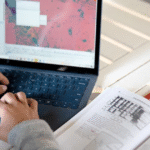Pediatric physical therapy helps children with physical, developmental, and neurological issues. It focuses on improving their movement, strength, and coordination. This is done through specific exercises, using equipment, and hands-on methods.
These therapists are trained professionals. They work with babies, kids, and teens. They have the skills to create healing and fun exercises for these young patients.
Key Takeaways
- Pediatric physical therapists use a variety of specialized techniques and equipment to help children with various conditions improve their physical abilities.
- Common techniques include core strengthening exercises, gross motor skill development, mobility exercises, and treatments for specific conditions like cerebral palsy and torticollis.
- Pediatric physical therapists work closely with children, their families, and interdisciplinary teams to create personalized treatment plans that address each child’s unique needs and help them reach their full potential.
- Early intervention and a focus on play-based, age-appropriate activities are key aspects of pediatric physical therapy.
- Pediatric physical therapy can make a significant difference in the lives of children with physical, developmental, and neurological challenges, helping them improve their mobility, strength, and overall well-being.
Introduction to Pediatric Physical Therapy
Pediatric physical therapy helps little ones and teens with various health challenges. These include physical, developmental, and neurological issues. Pediatric physical therapists are experts in this area. They focus on the unique needs of young people and are specially trained for it.
Importance of Early Intervention
Getting help early can make a big difference for kids with health problems like cerebral palsy. This is where pediatric physical therapists come in. They work to improve children’s gross motor skills and motor skills. This lets them join in regular activities, move better, and achieve their best.
Role of Pediatric Physical Therapists
Pediatric physical therapists create plans that meet each child’s needs. They use kid-friendly activities and special tools. These help kids get stronger, move better, and improve their balance and coordination.
Collaboration with Interdisciplinary Teams
They also team up with other experts, like occupational therapists and doctors. Together, they design unique rehabilitation services and therapy programs. This total-care approach covers everything from physical to thinking needs. It ensures each child gets the right help to do more and be their best.
Core Strengthening Exercises

Core strengthening exercises are key in pediatric physical therapy. They help kids build strong abdominal, back, and pelvic muscles. These muscles are vital for everyday actions such as playing, sitting, and moving around. By working on these specific areas, kids not only boost their core strength but also enhance their gross motor skills.
Stickers On Your Foot
This activity turns learning into fun. It involves putting stickers on kids’ feet. Then, kids try to peel them off. This strengthens their core and boosts their body awareness. Check out the OT Mom Learning Activities and Pink Oatmeal for more.
Stuffed Animal Elevator Rides
Kids can work on their core by ‘riding’ up and down on a balance ball or bean bag. As they do this fun activity, they hold a stuffed animal. It’s great for their belly muscles and also improves how they plan and move.
Make a Basket
Encouraging kids to reach and aim throws strengthens their core. It’s great for their coordination and body awareness. You’ll find this game at places like the NAPA Center and Little Steps, where it’s part of the therapy they offer.
Snake Curls
This next one involves kids turning into a snake. They lay on their backs and curl up slowly. It strengthens their core. It’s a fun way for them to work out their bodies. Especially helpful for kids who need extra care.
Gross Motor Skills Exercises

Building strong gross motor skills is a top goal in kids’ physiotherapy. These skills are crucial for stuff like skipping rope, biking, running, and kicking. Physiotherapists use fun, playful activities to boost children’s large muscle movements.
Chasing Bubbles
Chasing bubbles is not just fun but also boosts body awareness and movement planning. At places like the NAPA Center and Little Steps, kids learn to pop bubbles. This action helps a lot with upper body strength and coordination.
Simon Says
Simon Says is a classic for improving gross motor skills and body awareness. Kids jump, hop, and side-step as asked by the physiotherapists. This builds up their motor planning and coordination.
Playing Catch
Playing catch with a foam ball or soft, tossable objects is great. It challenges the child’s upper body strength, body awareness, and coordination. Physiotherapists worldwide use this game to help kids with less mobility improve their gross motor skills.
Bear Walk
The bear walk is a fantastic move that makes kids stronger and more aware of their bodies. Walking like a bear helps with core strength, coordination, and body awareness. Therapists sometimes add the crab walk or snake walk for more challenge and fun during the day.
Mobility Exercises
Children with conditions like cerebral palsy or muscular dystrophy may have trouble moving. To help, pediatric physical therapists use special exercises. They work on flexibility, strength, and coordination. This helps the kids move better and join fun activities.
Adapted Yoga
Adapted yoga is a great way to help these kids. Therapists might use chairs or walls for support. They lead children through poses like the warrior and side stretch. These exercise can enhance balance, body awareness, and more for those with cerebral palsy or muscular dystrophy.
Dancing
Dancing is another fun activity for improving mobility. Macarena or Electric Slide routines are popular. The freeze dance game helps with quick movements. This approach can boost coordination, motor planning, and mobility, all in a fun way.
Balloon in the Air
A balloon can be used for a creative mobility boost. This game explores buoyant force and water resistance. Children enjoy keeping the balloon up. It helps in walking, floating, and kicking. This improves movement and physical skills.
Pool Time
For those with more severe mobility limits, pool therapy works wonders. The water’s buoyancy supports their bodies. This reduces stress while they walk, float, and kick. Therapists make use of the pool’s unique features. They help with specific movement goals. This way, kids can enjoy activities similar to their everyday life.
Pediatric Physical Therapy for Specific Conditions
Pediatric physical therapy or physical therapy for children helps children with a variety of conditions. These may affect their growth and development. Some common issues treated include:
Preterm Infants
Preemies often need help with their breathing and moving. Pediatric physical therapists team up with doctors to give them early care. This helps preemies do better in movement, thinking, and feelings as they grow.
Cerebral Palsy
Cerebral palsy can make it hard for kids to move and stand. Therapists work to strengthen their muscles and improve their balance. They use special exercises to help these kids build skills to move better.
Torticollis
When a child’s neck muscles are tight, it’s called torticollis. This can make the child’s head tilt in a funny way. Physical therapists work with these kids to help them move their necks more freely. They also work with the family to do exercises at home.
Spina Bifida
Kids born with spina bifida can face many challenges. It’s a condition that affects the spine and can cause different problems. Physical therapists help these children move better and become stronger. They use special tools and exercises to overcome these issues.
Pediatric Physical Therapy Techniques

Pediatric physical therapists use special techniques for kids. They help with the distinct needs kids have. These include the Bobath, motor learning, the Margaret Rood, and Doman-Delacto methods.
Bobath Approaches
Karel and Berta Bobath created the Bobath methods. These help kids with conditions like cerebral palsy move better. They focus on using what you feel and how you move to improve.
Motor Learning
Motor learning in therapy means doing tasks over and getting feedback to get better. It helps kids with disabilities learn new actions. They enjoy therapies that are fun and helpful.
Margaret Rood Approach
Margaret Rood designed her method for kids with brain conditions. It uses special ways to touch and move them. The goal is to help kids control their moves better by fixing how they sense and move.
Doman-Delacto Technique
Glenn Doman and Carl Delacato’s method links the brain to how we move. They use exercises and things that feel or sound interesting. It helps kids grow their brain and learn to move as they should at their age.
Also Read: Understanding Your Medical Treatment Options
Evaluating and Monitoring Progress
Checking and keeping track of how kids progress in physical therapy is super important. This helps make sure that the treatment plan works well. Physical therapists who work with kids use lots of tools to see how the therapy is going. They then change the plan if needed.
First, the therapist looks at everything in a big check-up. They check the kid’s health history and what they can do physically. Together, they set goals for what the child can achieve. This starting point is key. It guides how they check and adjust the therapy over time.
As therapy goes on, the therapist keeps a close eye on how the child is doing. They look at things like how well they can move, how strong they are, and their balance. They also talk to the child and their family to get feedback. This helps them see if the treatment is working and if they need to change anything.
Watching the child’s progress allows the therapist to make the treatment fit just right. They want to make sure it’s helping the child reach their goals. These goals might be getting better at moving, getting stronger, or improving how they balance and coordinate.
FAQs
Q: What techniques are used in pediatric physical therapy sessions?
A: Pediatric physical therapy sessions may include a variety of techniques such as manual therapy, therapeutic exercises, balance and coordination training, strength training, gait training, and sensory-motor activities tailored to the specific needs of the child.
Q: How do physical therapy programs help children with developmental delays?
A: Physical therapy programs for children with developmental delays focus on improving muscle strength, balance, coordination, and mobility to help children reach their developmental milestones and improve their overall functional abilities.
Q: What happens during a pediatric physical therapy evaluation?
A: During a pediatric physical therapy evaluation, the therapist assesses the child’s physical abilities, movement patterns, muscle strength, coordination, balance, flexibility, and any underlying medical conditions or developmental delays to formulate an individualized treatment plan.
Q: How can pediatric patients benefit from physical therapy?
A: Pediatric patients can benefit from physical therapy by improving their motor skills, enhancing muscle strength, balance, coordination, flexibility, and mobility, managing pain or discomfort, promoting independence in daily activities, and reaching their full potential in physical development.
Q: How do pediatric therapy services help children and their families?
A: Pediatric therapy services provide comprehensive care to children by addressing their physical needs, improving their quality of life, supporting their developmental progress, empowering families with education and resources, and promoting a positive and nurturing environment for the child’s overall well-being.
Q: What specialized services do physical therapy programs offer for children?
A: Physical therapy programs for children offer specialized services such as outpatient pediatric therapy, individualized treatment plans, developmental screenings, early intervention programs, strength and conditioning programs, sports injury rehabilitation, aquatic therapy, and adaptive equipment recommendations.
Q: How can parents make an appointment for their child to receive pediatric physical therapy?
A: Parents can make an appointment for their child to receive pediatric physical therapy by contacting a children’s hospital or outpatient pediatric therapy clinic, providing their child’s medical history, insurance information, and scheduling an initial evaluation with the physical therapy team to discuss their child’s needs and treatment options.




